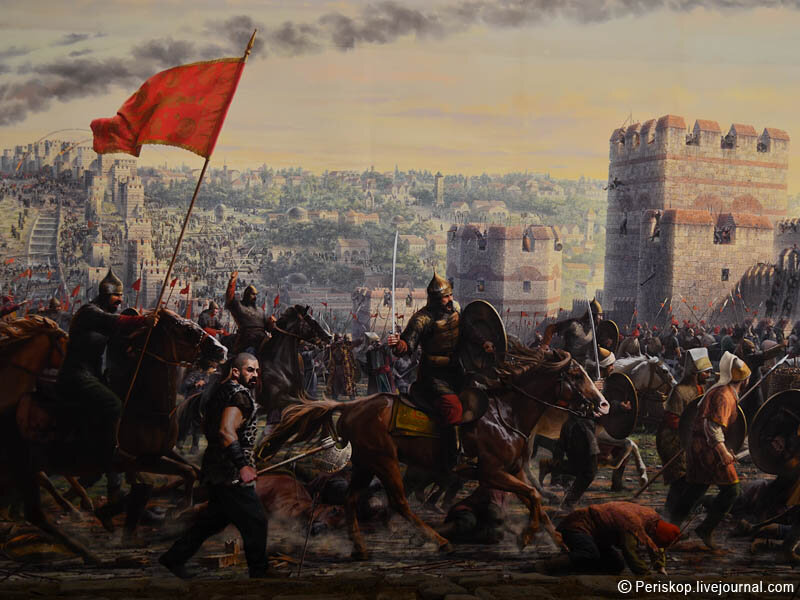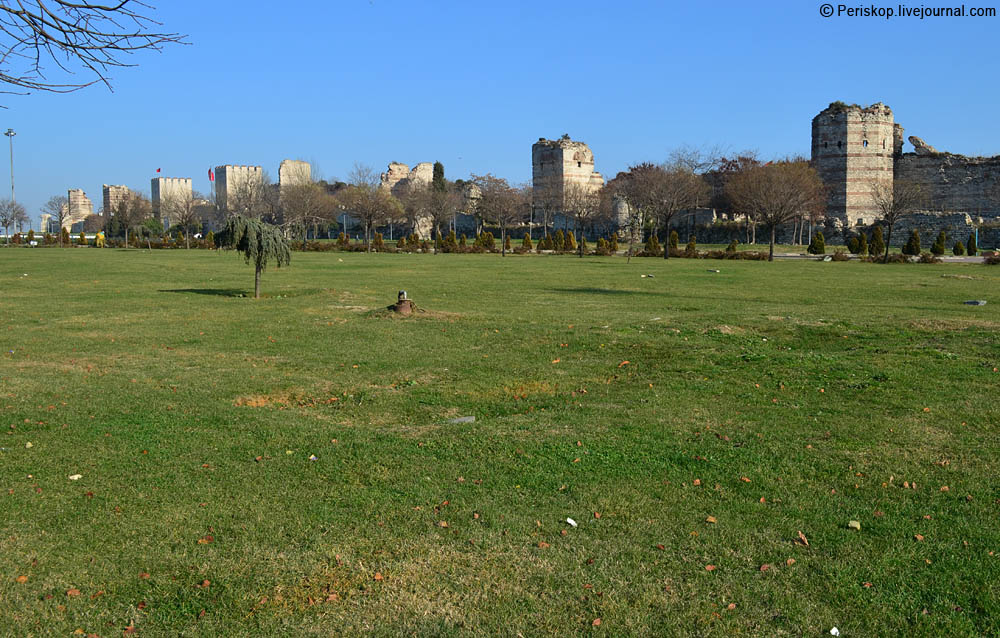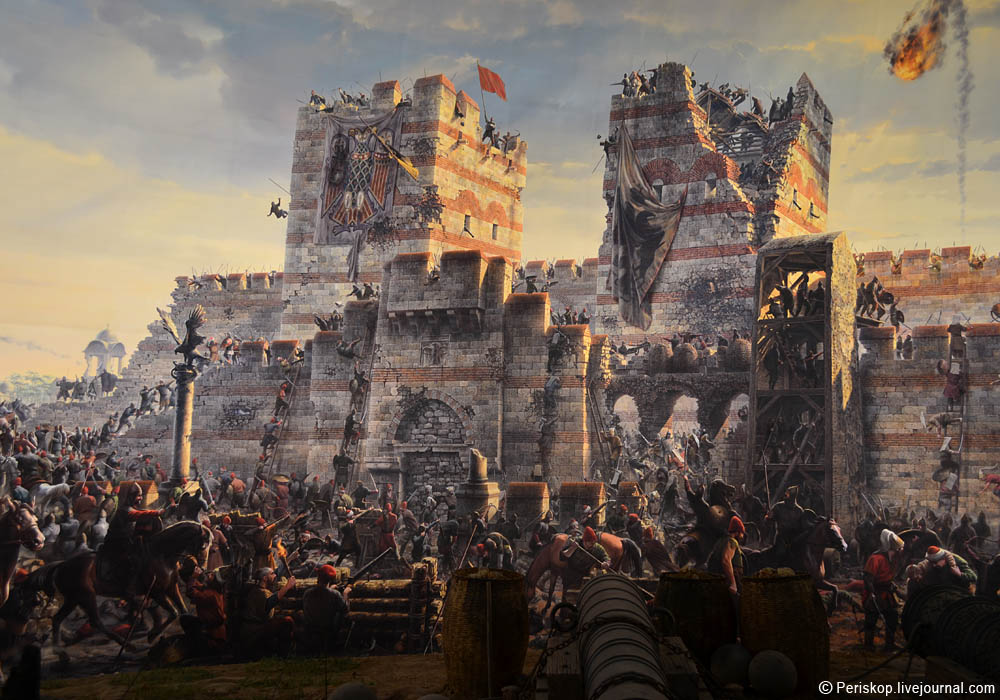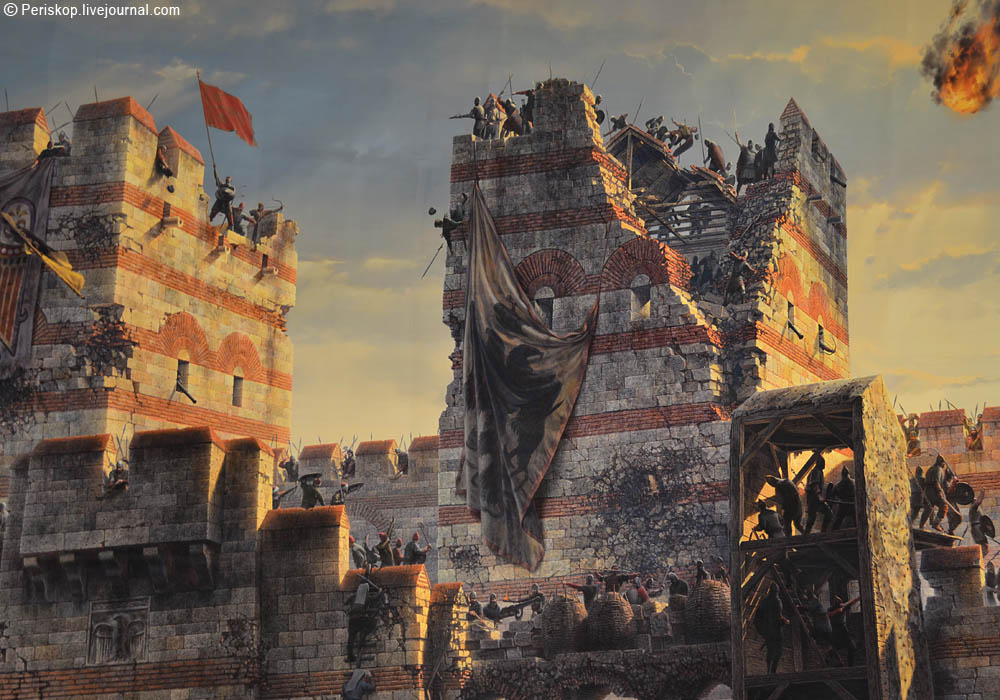We have long been accustomed to the idea that taking of Constantinople by the Turks - a kind of apocalypse, the tragedy, the collapse of the Second Rome, and the main bastion of the Orthodox world, the bitter loss, which must mourn. However, there is a viewing angle at which the assault on the town (its in the middle ages is well known, πόλις - and everyone was clear about what exactly the city speech) - the great and glorious milestone occasion for national pride. And the central figure in the assault, his inspirer and organizer - Sultan Mehmet II - most popular in modern Turkey, is a figure of number 2, just after most of Ataturk. The Sultan received after the successful capture of the capital of Byzantium, the honorary title of "Fatih" (Conqueror), his name is called the country's bridges, roads, streets, areas - including a second bridge over the Bosphorus.
***
Near the place Feodosievyh Wall, where the Ottoman forces managed to break into the city, most recently, in 2009, was built in 1453 Panorama (Panorama 1453 Tarih Müzesi), dedicated to this one of the key events in the formation of the Turkish nation. Wake up the country and national identity in the 2000s, this highly promoted, and now this museum is for Turks, one of the most popular. Foreigners in Panorama 1453 quite a bit, probably not more than one tenth of visitors - in contrast to other attractions and museums in Istanbul - so the museum can be rightfully called it Turkish.
Let's look at the end of Byzantine Constantinople, through the eyes of the victors.

Storming the Walls of Theodosius (near the gate of the Holy Roman), the victorious troops of the Ottoman
Two. Walls of Theodosius (the border of Byzantine Constantinople), I was completely on the Sea of Marmara to the Golden Horn. Generally, this is a unique phenomenon in the modern metropolis - ancient walls of V in. remained almost throughout their length, more than 6 kilometers. And, most interesting - not as an object of tourism, but simply as an artifact of the last undefeated. Whether it's in any major European city, with its relation to the modernization of urban infrastructure - the walls have long since no longer live. They probably could have lasted until the middle of the XIX century the maximum (by European standards) - but not in Turkey. The Turks are slow and inertia in the destruction of the buildings of the past, the mentality in their relation to the modernization of another. And that's why we have to this day, in the XXI century, we have this phenomenon.

Three. Around the middle stretch of the walls are slightly change direction and go down, following the folds of the relief - the valley of the stream Lycos. Look, there are two towers tselenkie and renovated, they stand out - this is the gate of St. Romanus, and Cannon (in Turkish Capa Topkapi). That's where the assault occurred the decisive events of the Byzantine capital. And if you turn toward the west (opposite wall) - you can see a squat round building.

4. This is the Panorama 1453. We are now here.

Five. At the top of the circle - the name of the museum.

6. On the walls round the building - scenes from the Ottoman Constantinople XVI-XVII centuries, made in a very beautiful technique (unfortunately, I do not know what it's called).

7. For example, one of the tracks - Hagia Sophia and the Egyptian obelisk.

Eight. Go. Ticket 10 pounds (160 rubles).. We met a large-scale image of Fatih.

9. Descend down. On the wall - a huge bas-relief, representing one of the legendary scenes preparing the assault - the crossing of the Ottoman galley fleet in the Golden Horn on the mountain. From the side of the Bosphorus, he was protected by a large chain the Byzantines.

10. For starters, you can see the different scenes of battle, maps, diagrams, engravings.

11. And on the model of Panorama in 1453 in a nutshell.

12. Here you can look around and the general disposition of the event on a beautiful pattern of Constantinople. From the south - the Sea of Marmara, to the east - the Bosphorus, is visible in the north of the Golden Horn and the gut Galata (Pera), on the west wall of Theodosius was besieged Ottoman forces. Above - Christian-Ottoman units Zaganos Pasha, Sultan Mehmed - roughly in the middle stretch of the walls.

Now climb up and look at pieces of the panorama.
13. Area Sultan rates near the walls. On the left, on a white horse - in fact the future Fatih.

14. Larger fragment. Note that the Sultan himself, and all his associates executed in the picture delicately and beautifully. There are no chipped, freaks, ugly, and so on. and so on. (A common method of belittling the psychological events - show freaks and bad looking people). So it should be in the national mythology.

15. The right of the Sultan - the famous Hungarian sverhpushka Urbana with a beautiful name Basilica (which later exploded). It is also part of a national legend.

16. Generally, the siege and storming of Constantinople went down in history for being a widely used and massed artillery. It was one of the first battles, where the concentration is a decisive impact on the problem of taking a large and strongly fortified city.

17. Therefore, models of artillery, nuclear, barrels in the foreground - this is an important part of the three-dimensional reconstruction of the events, they reinforce the general impression.

18. The massive use of artillery during the siege is not possible to simply destroy parts of the walls (which were then double), but also forces defenders to keep the City on the brink of exhaustion - they spent on the restoration of the walls, with a complete focus on their protection and periodic rest. Long way to sustain the Byzantines with the Genoese could not - and could not, with such a sinister sequence of the Ottomans.

19. A fragment of a closer look.

20. Horse soldiers, developing successful avant-garde.

21. The Byzantines, too, fought fiercely, and the Turks responded with fire. Many in the long history of Byzantium was ugly and even shameful pages, but the dying empire is beautiful, fighting - and the last emperor (Constantine XI) fell during the storm. It is true that the Byzantines themselves defenders were no more than half, many of them were the Genoese and the Venetians, who came to the aid of the City and fought as individuals, not as formal allies. But - it was too late.

22. The Ottoman army attacked the breach in the wall.

23. The work of the artillery - two walls, and exterior and interior, pretty much destroyed.

24. Decisive offensive Janissaries. Fragment: the wounded and dead among the attackers. All are depicted with respect, every detail is designed, no naturalism and krovischi.

25. During the Break - Greek Church of the City. Soon they will become mosques, many remain in the original Byzantine form, but without the crosses.

26. Attack of the Holy Roman gate.

27. On the north tower of the gate Byzantine double-headed eagle still holds. The man with the flag at the top - also the plot, which entered the national legends: Hasan brave warrior first hoisted the flag over the fortress tower, inspired the troops close to victory, and then was killed by the Byzantine boom, becoming a martyr.

28. The southern tower gate of double-headed eagle is dragged.

29. The Ottoman siege tower stormed the outer walls.

30. Of course, the most spectacular panorama performed for experience, and does not fully reflect the realities of the assault. They are then embellished and mythologized. For example, the main phase of the event took place back in the dawn twilight, the sun is not so high it was, etc. Much of this is dealt with in the book by R. Crowley, "Constantinople. End the siege." However, it is not so important - and here it is important that the panorama from the very inception, plays a very important national educational role. This lead the whole school classes, right conveyor belt (in my eyes as I looked, had three groups), and the guides tell them about the events of the valiant empire - and, guided tours tailored to different age groups: junior, middle and senior.

31. I must admit that it is good policy - targeted education of the younger generation as an example of the central, most important events in national history, with a positive sign. Schoolboy goes away with an understanding of "yes, we are a nation of winners," and it is postponed in the subcortex, but not with the type of self-flagellation, "oh we are freaks, do not know how to, behind, we are all bad and nothing happens." Then he looks into the desire for deeper and find out the events of their complexity, but the basic feeling still remains - "We're winners."

This is what would be nice to the Turks and learn, in my opinion - and throw a hysterical soul-searching in the depths of our own history, push it to a secondary position, so that saps the strength of the Russian World nations. Exactly the same positive mythologization national history and accentuation to engage in heroic events and the Anglo-Saxons, and the Chinese, not just the Turks. And we have well-run, unfortunately, the ugly self-flagellation, the desire obgadit more feasible, and large and small events, although the events of Russian history is dominated by the epic, heroic.
32. View of St. Sophia as a mosque after three centuries after the capture of Constantinople by Sultan Mehmed.

33. Fatih Sultan is present not only in the names of objects, but also in popular culture (popular books, cartoons, TV series, games, movies).

34. As I understand it, the events of 1453 are emblematic of the Turkish identity, and for them in bookstores - the mass of literature. Many and DVD, and other types of information carriers.

Conclusion: A very instructive to look at the long-familiar events of world history and on the other side. Much of this is seen after more than a body.
To be continued.
0. Introduction
A. City of cats
Two. Russian and Turkish Consulate General, "the hammer and sickle"
3. On metrobuse from Europe to Asia (video)
4. Istanbul flavor and character of the city
Five. Bosporus ferry traffic (video)
6. European train station Sirkeci
7. Railroad on the ruins of Constantinople (video)
8. Asian Haydarpasa train station
9. Turkish tea and the essence of edalni
10. Crossing the Bosphorus
11. Bosphorus Bridge
12. Hagia Sophia of Constantinople. Out
13. Hagia Sophia of Constantinople. From the inside
14. Hagia Sophia: rise to the top choirs and Review (video)
15. Underground Tank
16. Grand Bazaar and a big chaos
17. Fish Markets (Kumkapi and Galata)
18. Kapali Charshi and fish market in Galata (video)
19. transport system: trams trunk and nostalgic, light metro
20. transport system: the other entity
21. Panorama "The assault of Constantinople. In 1453"
***
Near the place Feodosievyh Wall, where the Ottoman forces managed to break into the city, most recently, in 2009, was built in 1453 Panorama (Panorama 1453 Tarih Müzesi), dedicated to this one of the key events in the formation of the Turkish nation. Wake up the country and national identity in the 2000s, this highly promoted, and now this museum is for Turks, one of the most popular. Foreigners in Panorama 1453 quite a bit, probably not more than one tenth of visitors - in contrast to other attractions and museums in Istanbul - so the museum can be rightfully called it Turkish.
Let's look at the end of Byzantine Constantinople, through the eyes of the victors.

Storming the Walls of Theodosius (near the gate of the Holy Roman), the victorious troops of the Ottoman
Two. Walls of Theodosius (the border of Byzantine Constantinople), I was completely on the Sea of Marmara to the Golden Horn. Generally, this is a unique phenomenon in the modern metropolis - ancient walls of V in. remained almost throughout their length, more than 6 kilometers. And, most interesting - not as an object of tourism, but simply as an artifact of the last undefeated. Whether it's in any major European city, with its relation to the modernization of urban infrastructure - the walls have long since no longer live. They probably could have lasted until the middle of the XIX century the maximum (by European standards) - but not in Turkey. The Turks are slow and inertia in the destruction of the buildings of the past, the mentality in their relation to the modernization of another. And that's why we have to this day, in the XXI century, we have this phenomenon.

Three. Around the middle stretch of the walls are slightly change direction and go down, following the folds of the relief - the valley of the stream Lycos. Look, there are two towers tselenkie and renovated, they stand out - this is the gate of St. Romanus, and Cannon (in Turkish Capa Topkapi). That's where the assault occurred the decisive events of the Byzantine capital. And if you turn toward the west (opposite wall) - you can see a squat round building.

4. This is the Panorama 1453. We are now here.

Five. At the top of the circle - the name of the museum.

6. On the walls round the building - scenes from the Ottoman Constantinople XVI-XVII centuries, made in a very beautiful technique (unfortunately, I do not know what it's called).

7. For example, one of the tracks - Hagia Sophia and the Egyptian obelisk.

Eight. Go. Ticket 10 pounds (160 rubles).. We met a large-scale image of Fatih.

9. Descend down. On the wall - a huge bas-relief, representing one of the legendary scenes preparing the assault - the crossing of the Ottoman galley fleet in the Golden Horn on the mountain. From the side of the Bosphorus, he was protected by a large chain the Byzantines.

10. For starters, you can see the different scenes of battle, maps, diagrams, engravings.

11. And on the model of Panorama in 1453 in a nutshell.

12. Here you can look around and the general disposition of the event on a beautiful pattern of Constantinople. From the south - the Sea of Marmara, to the east - the Bosphorus, is visible in the north of the Golden Horn and the gut Galata (Pera), on the west wall of Theodosius was besieged Ottoman forces. Above - Christian-Ottoman units Zaganos Pasha, Sultan Mehmed - roughly in the middle stretch of the walls.

Now climb up and look at pieces of the panorama.
13. Area Sultan rates near the walls. On the left, on a white horse - in fact the future Fatih.

14. Larger fragment. Note that the Sultan himself, and all his associates executed in the picture delicately and beautifully. There are no chipped, freaks, ugly, and so on. and so on. (A common method of belittling the psychological events - show freaks and bad looking people). So it should be in the national mythology.

15. The right of the Sultan - the famous Hungarian sverhpushka Urbana with a beautiful name Basilica (which later exploded). It is also part of a national legend.

16. Generally, the siege and storming of Constantinople went down in history for being a widely used and massed artillery. It was one of the first battles, where the concentration is a decisive impact on the problem of taking a large and strongly fortified city.

17. Therefore, models of artillery, nuclear, barrels in the foreground - this is an important part of the three-dimensional reconstruction of the events, they reinforce the general impression.

18. The massive use of artillery during the siege is not possible to simply destroy parts of the walls (which were then double), but also forces defenders to keep the City on the brink of exhaustion - they spent on the restoration of the walls, with a complete focus on their protection and periodic rest. Long way to sustain the Byzantines with the Genoese could not - and could not, with such a sinister sequence of the Ottomans.

19. A fragment of a closer look.

20. Horse soldiers, developing successful avant-garde.

21. The Byzantines, too, fought fiercely, and the Turks responded with fire. Many in the long history of Byzantium was ugly and even shameful pages, but the dying empire is beautiful, fighting - and the last emperor (Constantine XI) fell during the storm. It is true that the Byzantines themselves defenders were no more than half, many of them were the Genoese and the Venetians, who came to the aid of the City and fought as individuals, not as formal allies. But - it was too late.

22. The Ottoman army attacked the breach in the wall.

23. The work of the artillery - two walls, and exterior and interior, pretty much destroyed.

24. Decisive offensive Janissaries. Fragment: the wounded and dead among the attackers. All are depicted with respect, every detail is designed, no naturalism and krovischi.

25. During the Break - Greek Church of the City. Soon they will become mosques, many remain in the original Byzantine form, but without the crosses.

26. Attack of the Holy Roman gate.

27. On the north tower of the gate Byzantine double-headed eagle still holds. The man with the flag at the top - also the plot, which entered the national legends: Hasan brave warrior first hoisted the flag over the fortress tower, inspired the troops close to victory, and then was killed by the Byzantine boom, becoming a martyr.

28. The southern tower gate of double-headed eagle is dragged.

29. The Ottoman siege tower stormed the outer walls.

30. Of course, the most spectacular panorama performed for experience, and does not fully reflect the realities of the assault. They are then embellished and mythologized. For example, the main phase of the event took place back in the dawn twilight, the sun is not so high it was, etc. Much of this is dealt with in the book by R. Crowley, "Constantinople. End the siege." However, it is not so important - and here it is important that the panorama from the very inception, plays a very important national educational role. This lead the whole school classes, right conveyor belt (in my eyes as I looked, had three groups), and the guides tell them about the events of the valiant empire - and, guided tours tailored to different age groups: junior, middle and senior.

31. I must admit that it is good policy - targeted education of the younger generation as an example of the central, most important events in national history, with a positive sign. Schoolboy goes away with an understanding of "yes, we are a nation of winners," and it is postponed in the subcortex, but not with the type of self-flagellation, "oh we are freaks, do not know how to, behind, we are all bad and nothing happens." Then he looks into the desire for deeper and find out the events of their complexity, but the basic feeling still remains - "We're winners."

This is what would be nice to the Turks and learn, in my opinion - and throw a hysterical soul-searching in the depths of our own history, push it to a secondary position, so that saps the strength of the Russian World nations. Exactly the same positive mythologization national history and accentuation to engage in heroic events and the Anglo-Saxons, and the Chinese, not just the Turks. And we have well-run, unfortunately, the ugly self-flagellation, the desire obgadit more feasible, and large and small events, although the events of Russian history is dominated by the epic, heroic.
32. View of St. Sophia as a mosque after three centuries after the capture of Constantinople by Sultan Mehmed.

33. Fatih Sultan is present not only in the names of objects, but also in popular culture (popular books, cartoons, TV series, games, movies).

34. As I understand it, the events of 1453 are emblematic of the Turkish identity, and for them in bookstores - the mass of literature. Many and DVD, and other types of information carriers.

Conclusion: A very instructive to look at the long-familiar events of world history and on the other side. Much of this is seen after more than a body.
To be continued.
0. Introduction
A. City of cats
Two. Russian and Turkish Consulate General, "the hammer and sickle"
3. On metrobuse from Europe to Asia (video)
4. Istanbul flavor and character of the city
Five. Bosporus ferry traffic (video)
6. European train station Sirkeci
7. Railroad on the ruins of Constantinople (video)
8. Asian Haydarpasa train station
9. Turkish tea and the essence of edalni
10. Crossing the Bosphorus
11. Bosphorus Bridge
12. Hagia Sophia of Constantinople. Out
13. Hagia Sophia of Constantinople. From the inside
14. Hagia Sophia: rise to the top choirs and Review (video)
15. Underground Tank
16. Grand Bazaar and a big chaos
17. Fish Markets (Kumkapi and Galata)
18. Kapali Charshi and fish market in Galata (video)
19. transport system: trams trunk and nostalgic, light metro
20. transport system: the other entity
21. Panorama "The assault of Constantinople. In 1453"
__._,_.___
" Minuman para Anbia : http://higoat-2009.blogspot.com/"
" Anda masih mencari jodoh? Lawati http://www.myjodoh.net"
" Kertas Soalan Ramalan Matematik 2010 : http://maths-catch.com/exam"
" Kedai Maya : http://halawahenterprise.blogspot.com/"
" Blog Sahabat RG : http://azwandengkil.blogspot.com"
Terima kasih kerana sudi bersama kami. Untuk mendapatkan maklumat lanjut tentang ReSpeKs Group, sila ke : http://respeks-group.blogspot.com.
Segala email yang tersiar melalui Respeks Group adalah tanggungjawab penulis asal email. Owner atau moderator tidak bertanggungjawab ke atas setiap email yang disiarkan dan sebarang dakwa dakwi tiada kena mengena dengan moderator group.
" Anda masih mencari jodoh? Lawati http://www.myjodoh.net"
" Kertas Soalan Ramalan Matematik 2010 : http://maths-catch.com/exam"
" Kedai Maya : http://halawahenterprise.blogspot.com/"
" Blog Sahabat RG : http://azwandengkil.blogspot.com"
Terima kasih kerana sudi bersama kami. Untuk mendapatkan maklumat lanjut tentang ReSpeKs Group, sila ke : http://respeks-group.blogspot.com.
Segala email yang tersiar melalui Respeks Group adalah tanggungjawab penulis asal email. Owner atau moderator tidak bertanggungjawab ke atas setiap email yang disiarkan dan sebarang dakwa dakwi tiada kena mengena dengan moderator group.
.
__,_._,___
No comments:
Post a Comment